Thu 20 May 2010 17:15 » Jon
Last night I handed in my security pass and left RBS for the final time. For the first time since I was at university, I’m now unemployed.

The guys from work bought me an awesome Leatherman Blast as my leaving present, then joined me for some drinks in a bar near the office. The Leatherman was one of the last few things left to buy from the kit list - probably the most useful leaving present ever!
Although I’ve been looking forward to this point for months, the last few days I’ve felt a bit nervous about the whole thing, wondering whether quitting a job is such a great idea after all. It’s going to take a while to get used to the idea, but I’m pretty sure it’s the right thing to do!
I’m off to Scotland to test out my kit next week, so the main focus now is getting the last few bits and bobs. I then need to pack it all, see how much it weighs, then start trying to figure out what I can leave behind…
Sat 08 May 2010 11:38 » Jon
There’s so much to sort out! If I was just going to set off and walk on my own then there’d be no need to plan a schedule in any great detail, but I’m hoping that various friends will be joining me along the way. To make that possible, I need to be able to give at least a rough idea of where I’m going to be on any given day. That sounds simple enough, but it depends on a load of important decisions.
When do I start?
Having decided that I’m going to push the start date back from my original idea of June 1st, I need to decide how far. I’ve already moved one mountain-biking trip from early August to early September, but the second one is less easy to move, so that’s my hard deadline - I need to be back at the very latest by August 13th so I can be ready to leave on August 14th. Once I’ve decided on the exact route then I ought to be able to come up with a start date to allow me to get back sometime during that second week of August.
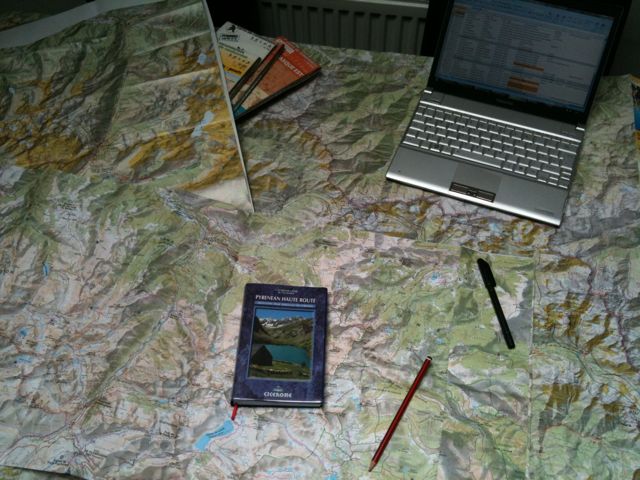
Do I stick to the official HRP route?
The first question about the route was whether I simply follow Joosten’s suggestion or do my own thing here and there. There are places from the original GR10 trip I did in 1996 that I’d always thought I’d go back to but, having sat down with maps and looked at where I’m going to camp, where I can buy food, fuel etc, I’ve decided it will be easier to just stick to the guidebook. The route covers eleven maps, and I’ve now plotted the route as far as the tenth. I’ll be camping most of the time and cooking on my stove, but there are times when I can’t re-stock food for up to 9 days, so I’m going to eat in refuges where possible to minimise the food I need to carry during these sections.
Do I stick to the schedule?
If I’m following the guidebook’s route then I could simply assume that I’ll make the timings suggested but I suspect that, as the weeks go by, I’ll start beating the times. Even if they turn out to be accurate, I may want to go further than the schedule on some days, and stop earlier on others. I’ve made some minor changes to even out the length of some days, but apart from this I’m using the book’s times. Hopefully the good days and the bad days will balance each other out, but if not I can always drop some of the Classic Summits.
Which “Classic Summits”?
The guide book has ten summit ascents that are recommended in addition to the 45 day stages. To begin with I was thinking I’d try to do as many of them as possible (i.e. I’d do them all unless they needed ropes for glacier crossings and I was solo), but I think I’m going to be a bit more selective. Some of them are easy to fit into a normal day (e.g. the summit is just off the route) but others require a day of their own. I’ve planned in 6, and would really like to do Vignemale as well, but it has a dangerous glacier so I’ll probably have to give that one a miss.
How many rest days?
One of the mistakes we made 14 years ago was walking the first 15 days without a break. I twisted my ankle as a result and had to rest for several days, which is not something I want to repeat! It would be nice to be able to take a break when my body feels like it needs one but that doesn’t fit well when you’re trying to predict where you’ll be in advance. The plan currently has rest days when I reach the stage ends (roughly every 10 days), which are in villages, so I can eat, relax and hopefully recharge. If I need more rest days then I’ll either have to sacrifice some of the summits or slip the dates back.
I’m finally beginning to feel like I have a reasonable plan. As soon I’ve worked out the last few days then I should be able to decide on a start date and book some trains…
Fri 07 May 2010 22:43 » Jon
I’ve been steadily researching and acquiring more gear over the last few weeks, which has helped build the excitement to the point where I’m struggling to sleep when I lie down at night!

Following on from the tent, I’ve now got a light-weight Grivel Air Tech Evo ice axe, some Grivel Air Tech crampons, a PowerMonkey Explorer solar charger and a super-flexible Primus Omnifuel stove that can burn just about anything. I still have to buy some pans but I’ve got my eye on some lightweight titanium pans from Alpkit (although the Primus Eta pans have come in a close second).
A guy in a shop in North Wales recommended some modifications to my layering, so I’m probably going to invest in a Rab Vapour Rise top and Primaloft jacket, which together should mean I can leave fleece and down jackets behind, saving space and weight.
The biggest trauma has followed on from the news that my trusty old Manta M4 boots are now too flexible for crampons. I decided to buy new boots and invested in some Scarpa Cristallo boots - lighter than the leather alternative (the SL) and hopefully quicker to break in. Unfortunately despite 5 trips to 4 shops, I couldn’t get a pair that fitted without squashing my toes, so I’ve switched to the SL. These are much more comfortable and I’m just hoping I can break them in in time.
Wed 07 Apr 2010 22:48 » Jon
Having discussed crampons at great length over the weekend in Ambleside, I took one of my boots into Snow and Rock this evening to get some advice about which type of bindings would work best. My boots (some ancient Scarpa Mantas) are not super-technical, but were designed to take walking crampons for crossing snowfields and glaciers.
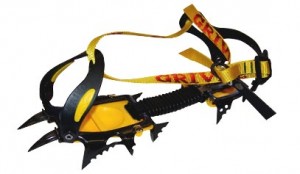
Unfortunately the boots are getting on a bit (possibly 10+ years old - I can’t actually remember buying them) and they were re-soled last year after a Guatemalan volcano (Pacaya, since you asked) melted the glue binding the original soles. The distance the boots have walked and the re-soling have combined to leave them considerably more flexible than they were originally - so much so that they are now apparently beyond the limit for even walking crampons.
I’m left with a choice of buying a new pair of stiffer boots, using crampons with the existing boots and accepting that they may fall off, or just ignoring crampons completely. The second and third choice sound downright dangerous, while the first leaves me with a pair of boots that need breaking in. I’m not going to be able to walk much for the next couple of weeks, so if I go for that option then I’m going to be left with 6 weeks to break in a new pair of boots.
If I did decide to get new boots, then there’s the question of which ones. I’ve always liked the look of the new Mantas, but they’re rated B2, so are probably a bit stiffer than I need for a 2-month trek across the Pyrenees. But if I go for something more flexible then will it be up to the extended crampon-use of my trip to Nepal later in the year? It’s all getting rather complicated…
Mon 05 Apr 2010 22:22 » Jon
Following the broken rib 5 weeks ago, painkiller-allergy 4 weeks ago and hernia operation 3 weeks ago, I’m unable to walk too far at the moment, and haven’t yet ventured back onto a bike. Normally this would make a stay in Ambleside rather frustrating, but while the rest of my family are out cycling the Fred Whitton or walking, I’ve been discussing tents, stoves, ice-axes, crampons and water-purification with the shop-assistants here.
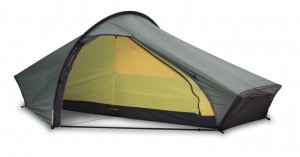
Much of the kit requires a bit more research but I’d already decided that the Hilleberg Akto was at the top of the tent shortlist, so it was a pleasant surprise to discover one set up in the first shop I visited here – The Climbers’ Shop. The Akto is renowned as a great one-man tent, hardy enough to survive extended high-mountain conditions but weighing only around 1.5kg, which compares very well with the more flimsy ultra-light tents designed for mountain marathons.
I had a good look over the tent from outside, then jumped inside and closed it up. Inside it’s not quite the Tardis but it is surprisingly roomy. Even though I’m 6’1”, there was length to spare when I lay down, and there’s room inside to store kit if the vestibule gets too damp. I can also sit up inside it, which is quite important if I’m going to spend 2 months living it!
The one negative comment I’ve read about the Akto is that it can suffer from condensation. I asked the chaps in the shop about this and one said that with the vents open it was normally ok but using a footprint can help, as this prevents the moisture coming up out of the ground underneath the tent. I’m going to take the tent for a weekend up in Scotland sometime to test it out and I’ll see how the condensation goes, but I’d rather avoid the extra weight of a footprint if I can avoid it.
I’ve got just over 6 weeks left at work (they decided not to offer me the sabbatical), so need to complete my recovery from the op, buy the remaining gear and get out there to build some fitness and make sure all the kit works. Having read about the snow in June I’m now aiming to start a week or two later than originally planned, which gives me just over 2 months until I leave Hendaye…
Sat 13 Mar 2010 00:10 » Jon
I dropped into Stanfords earlier this evening, hoping to find a copy of the new guidebook I’m going to take to the mountains, and left about an hour later and over £120 worse off!
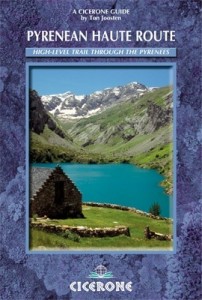
Last time we were in the Pyrenees we took the original guidebook written by Georges Veron when he came up with the idea of the HRP back in the late 1960s. In the intervening 14 years I’ve mislaid that, so decided to try the “other” guide - Ton Joosten’s “Pyrenean Haute Route”. The second edition of this was only published last year, so hopefully it’s going to be up-to-date with any changes on the ground.
The guide seems pretty comprehensive, with the usual advice on weather, kit, how hard each day is and so on, but I’m a little put off by the advice not to walk any of the route on your own! Although there are obviously additional risks to doing something like the HRP on your own, I don’t think it should just be dismissed - as long as the risks are taken into account then walking solo can be hugely rewarding.
The other slightly alarming piece of advice is regarding the best months to go. Based on rainfall, I’d decided June/July/August would all be much the same but I hadn’t thought too much about the snow left over from the winter. Joosten advises setting off at the beginning of July to minimise the likelihood of snow - I’m planning to start walking at the beginning of June, so will have to hope for a warm spring.
Crampons and ice axes aren’t required for most of the main route but there are ascents of “10 Classic Summits”, in addition to the main route, where they’re recommended. Some of those ascents involve glacier crossings, so I think I’ll probably have to give those a miss unless I’m with friends at those points - crossing a glacier without a rope is not a great idea. Still, the more I think about it, the more inclined I am to take crampons and an axe.
The guide also contains a list of recommended maps so I’ve also picked up as many of them as I could find though, worryingly, some appear to be out of print! I remember thinking the European maps were poor on our previous attempt. Some of the French ones have been updated and now have a decent grid with markings on, but the others, and all of the Spanish ones, are pretty rubbish compared with the maps we’re used to in the UK. It makes me realise how lucky we are with the OS maps.
I’ve also invested in my first ever Moleskine notebook, for use when there isn’t enough sun to keep the iPhone going.
Mon 01 Mar 2010 21:00 » Jon
Three months from today I should be setting off from Hendaye, with 800km of Pyrenees ahead of me.
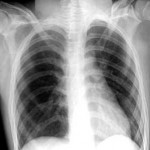
Right now though, nothing could seem further from reality. As a result of a stupid snowboarding accident I’m sitting in a bar in Aspen with a broken rib. The doctor here thought I might have damaged my liver as well, but luckily $3k worth of CAT scan has shown that all is well. Apparently the ribs should be back to normal in 6 weeks or so.
In two weeks I’m going under the knife to have a hernia sewn up too! I’ve been postponing that for about 18 months, but finally decided it would be sensible to get it fixed before isolating myself in the mountains (and while I still have medical insurance!). If all goes well, the incision should be fully healed up by the beginning of May.
As well as some great powder, Aspen has an exellent outdoor shop called Ute Mountaineer, so I’ve spent several hours in there eyeing up kit and discussing things with the staff. I still have loads of decisions to make, including choosing a tent and a stove, but I’ve picked up an X-Mug and a cool lightweight spork.
Sat 20 Feb 2010 11:58 » Jon
Until Thursday, it was all just talk.
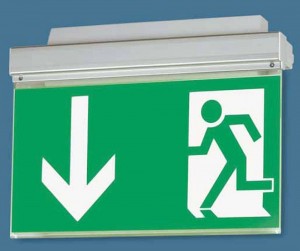
I had planned to resign on Friday but discovered at about 16:00 on Thursday that my boss, Andy, was having Friday off, so when he came out of his meeting I took him into a room and gave him the news.
He said he’d known it was coming, but hadn’t expected it this soon. With a three month notice period I didn’t have much choice though, as the plan is to start the HRP at the beginning of June.
There’s still a tiny chance that RBS will reconsider their decision not to give me a sabbatical, now that I’ve made my move. Although having to be back by a certain date would limit my flexibility, knowing I had a job to come back to would certainly make my parents happier!
Either way, the wheels are now in motion.
Mon 01 Feb 2010 22:03 » Jon
Training for the Pyrenees has begun! Pete Smith and I spent the weekend in Snowdonia, where we hoped to climb some of the Welsh 3000s, but the weather was much worse than forecast and we never actually made a summit.
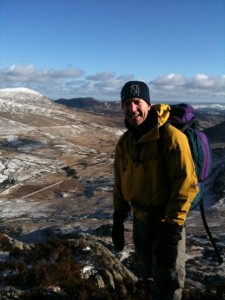
The plan had been to start with Tryfan, head along the Glyders, then even consider taking in Snowdon before heading back to camp on the Glyders. Unfortunately the scramble up the north face of Tryfan took way longer than expected, and ultimately ended in failure: we met various groups who’d given up at a steep snowy gully, and when we went round to have a look we decided they’d made the right decision.
We were traversing across a pretty steep snowfield to get to the gully, but the gully itself was much worse. It was steep and icy, and fed straight off the edge of a cliff, so a slip would have been messy. At this stage we both realised that crampons and ice axes would have made life a lot easier - unfortunately the forecast had been for light rain, so we were ill-equipped.
It was a slightly disappointing day, partly because we didn’t make the summit and partly because we spent almost the whole day in the shade. Although the sky was clear we were in the shade of the mountain, and we kept looking across to Pen yr Ole Wen and the Carneddau in glorious sunshine, wishing we’d gone up the other side of the valley!
We climbed back down almost to the A5, then walked along to camp near Llyn Idwal. It was a cold and snowy night, but it was good to test the kit and quite fun to be out in the open on such a bitter night.
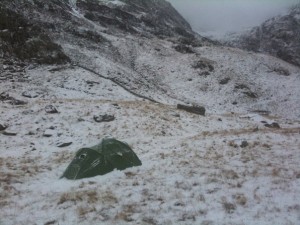
Sunday started cloudy, with occasional snow-storms sticking around. After packing up the tent we set off to climb Y Garn, hoping we could get to the ridge up an easier route and knock off a few summits to make up for the previous day.
The snow got worse as we climbed and by the time we approached the ridge our tracks were being covered almost as soon as we took the next step. The wind was howling over the buttress we were climbing and spitting hail in our faces, which was so painful at times we had to stop and turn away from it.
We were kicking steps for the last few hundred metres, but near the top the slope got steeper and the snow shallower, so we were kicking straight into the ice. Without crampons it all began to feel a bit sketchy, then we spotted a 4 or 5 foot cornice on the top of the ridge. We couldn’t see far along the ridge to check if the cornice was continuous due to the cloud, but from what we could see there was no way to attack it, especially not without ice axes. Even with the right kit, we weren’t sure what the best way to deal with it would be, as we were once again at the top of a steep slope that would have sent us down several hundred feet if we’d slipped.
We retreated down the way we’d come and got thoroughly annoyed when group after group asked “how was it on the top?” and we had to explain that we hadn’t actually got there!
On the positive side, we got back down safely and definitely learnt our lesson: if you’re going mountaineering in the middle of winter on some of Wales’ biggest summits, remember to take winter mountaineering kit!











